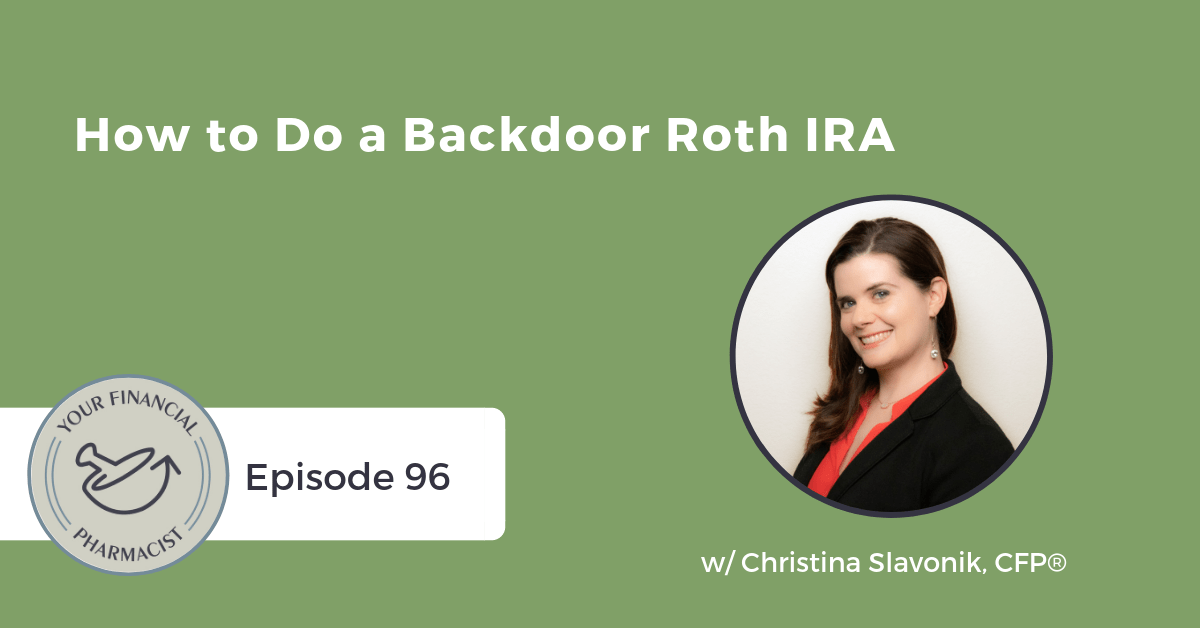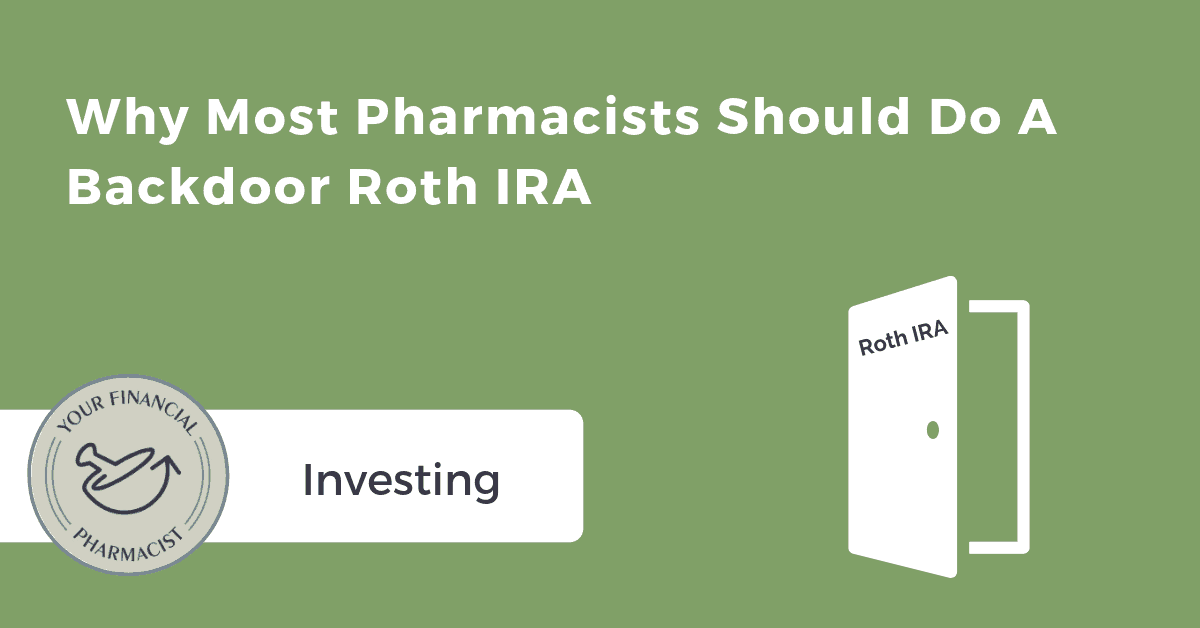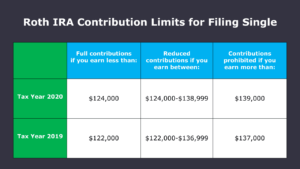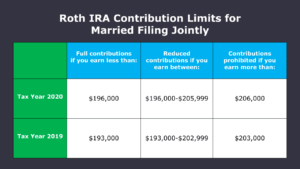How to Do a Backdoor Roth IRA
On this episode, Tim Baker welcomes Christina Slavonik, CERTIFIED FINANCIAL PLANNER™ and the newest member of the YFP family, to the show. Tim and Christina break down how to do a backdoor Roth IRA conversion, a move that most pharmacists should consider making.
About Today’s Guest
Christina joins us with approximately 15 years of experience in the financial services industry. After serving in various capacities, she attained her Registered Paraplanner℠ designation in 2013 and then her CERTIFIED FINANCIAL PLANNER™ designation in 2017. She currently resides in Ft. Worth, Texas with her husband, Paul, and their two cats.
Summary
Christina Slavonik has been working for YFP for a couple of months as a CERTIFIED FINANCIAL PLANNER™. On this episode, Christina and Tim discuss how to do a backdoor Roth IRA, also known as a Roth IRA conversion.
First, Tim Baker reminds listeners to follow “Baker’s Buckets”, meaning that you should always start saving for retirement with an employer match when available as this is free money. From there, it might make sense to max out an IRA or HSA. After you’ve maxed out your IRA and HSA, go back to your employer 401(k) or 403(b) plan to add in the $19,000 you can put in every year.
Most pharmacists bring in around $125,000 a year, meaning they cannot deduct their traditional IRA contribution as they are above the income limits. In 2019, single taxpayers with a MAGI of $122,000 and married filing jointly taxpayers with a combined income of $193,000 can’t contribute directly to a Roth IRA.
Christina explains that you can instead do a backdoor Roth IRA. First, open up a traditional IRA if one is not already opened and contribute the first $6,000. Then, you can make the conversion by filling out and submitting the appropriate forms. You are then able to convert the nontraditional money to a Roth IRA.
Christina and Tim discuss how to contribute to these accounts, best practices for waiting periods, steps for filing taxes if you contributed an excess amount to an IRA, and a recap of the Roth IRA conversion process.
Check out this blog post for more information on backdoor Roth IRAs.
Mentioned on the Show
- Pharmacy Graduate Survival Kit
- tl;dr
- Indispensable: The Prescription for a Fulfilling Pharmacy Career by Alex Barker
- First Time Pharmacist: Everything You Didn’t Learn in School or On The Job Training by Richard Waithe
- 7 Figure Pharmacist
- Your Financial Pharmacist
- YFP Planning
- YFP Blog: Why Most Pharmacists Should Do a Backdoor Roth IRA
- YFP 093: Highlights from APhA Annual Meeting
- YFP 073: How to Determine the Priority of Investing
Episode Transcript
Tim Baker: What’s up, everybody? Welcome to Episode 096 of the Your Financial Pharmacist podcast. I am so excited to welcome back Christina Slavonik, our newest member to the YFP family. I know, Christina, we heard a little bit from you at APhA Seattle, so welcome back to the podcast.
Christina Slavonik: Yes, thanks so much, Tim. I’m glad to be back.
Tim Baker: So I guess, you know, Christina, just to put you on the spot here, you know, you’ve been working with us for the last couple of months.
Christina Slavonik: Yes.
Tim Baker: How has it been at YFP? And what’s different about us?
Christina Slavonik: Sure. Yeah, it’s been so refreshing. Just really a breath of fresh air just working with —
Tim Baker: Awh, shucks.
Christina Slavonik: Younger people, you know? And we all have, you know, the same kind of not really have the same backgrounds, but at least we have the same things that we’re all working through and especially when you’re able to narrow down your clientele to one niche, it really helps you focus on what they’re really needing, what they’re really wanting, and then being able to share your own life stories as you go through that path together.
Tim Baker: Yeah, I think it’s one of those things where, you know, in my past life, I would work for firms that was kind of a jack-of-all-trades, kind of master-of-none type of thing. That’s not really our game. You know, we really want to focus in on the big issues that are facing pharmacists out there and really provide good service and solutions to really tackle those issues. So today, we’re going to talk about Roth conversions. Like I mentioned, it can be a little bit of a technical subject, but one of the things that we probably should mention first as we kind of get into our list of steps here is way back when in Episode 073, How to Determine Priority Investing, we kind of talk about what Tim Church has deemed “Baker’s Buckets.” So typically when I sit down with clients, you know, I say, “Hey, client, typically how we like clients, pharmacists to really fill their retirement buckets, you know, you should always start with your employer match. So if your employer match is 3%, 5%, 7%, that’s free money.” And nine times out of 10, that should be what we are trying to get, get at least to the match. But from there, depending on the 401k or the 403b, what that plan looks like, not everyone’s 401k, not everyone’s 403b, is going to be equal. So there are some really great 401k’s and 403b’s out there. There are some that are kind of not so great. So it might make sense to kind of go into the IRA world or the HSA world and really max out that bucket next. So typically, for the IRAs for 2019, you can put in aggregate between the Roth IRA and the traditional IRA, $6,000 per year. So that’s roughly $500 per month. In the HSA world, the Health Savings Account, which we’ve talked about time and time again, it’s the only account out there that has a triple tax benefit. So basically it goes in pre-tax, it grows tax-free, and then it comes out tax-free if it’s used for qualified medical expenses. You typically, for a single individual, it’s $3,500 per year that you can do. Or if you’re a family, $7,000 per year. So once we max those out, then it might make sense to go back into the employer plan, the 401k, the 403b, and get to that $19,000 that you can put in — this is not counting your employer contribution — that you can put in every year into that 401k. So Christina, now that we kind of have “Baker’s Buckets” aside and we’re diligently putting in a contribution into the IRA, what happens next with regard to this whole conversion? And why would I convert I guess to begin with?
Christina Slavonik: Sure. Well, in looking at the typical pharmacist’s salary, which I believe is around — latest stats is around $124,000-125,000. You already know that you cannot contribute directly to a traditional IRA. Well, you can, but you can’t deduct it. So that’s the caveat with that. So where the Roth IRA comes into play is most of the times, you won’t be able to contribute directly to the Roth because of your income limits. So I know for 2019, if you’re single and you make an income, a modified adjusted gross income, of $122,000 or if you’re married filing jointly and you’re making an income of $193,000, then you can’t contribute directly to a Roth. So how you can do that is by doing a backdoor Roth IRA or it’s also known as a Roth conversion. And what you will need to do is open up a traditional IRA, and this is assuming you don’t already have a traditional IRA open. We’ll get into the reason why — what will happen if you do currently have a traditional IRA. But first things first, you open the traditional IRA, you put your — say you’re going to max out your contribution for the year — you’d put your contribution in there first of $6,000. And then you can make what’s called a Roth conversion, and normally your firm, your wealth provider, whoever you have your investments with, they should be able to walk you through what forms are needed. You fill out the form, submit it, you have a Roth IRA opened. And then you’re able to convert those traditional dollars, non-deductible traditional dollars, into your Roth IRA. And the beauty of that is not only is your money going to be in the Roth, but it’s going to be after-tax, you’re not going to have to pay any taxes for it going in because you just made the non-deductible contribution. You will have the earnings grow tax-free. And then if you’re — there’s certain stipulations about once you hit retirement or you’ve had the account open for five years, you can start to withdraw those contributions and earnings tax-free. So there are many, many other benefits to having the Roth IRA. One, you do not have to make what’s called a required minimum distribution. And with a traditional IRA, you have to start pulling out money at the age 70.5. You have no choice.
Tim Baker: Right.
Christina Slavonik: But with the Roth IRA, you avoid that altogether as well.
Tim Baker: So just to recap on that, you know, and to back up, anytime that you see “Roth,” you automatically should think after-tax. So whether that’s a Roth IRA, a Roth 401k, a Roth 403b, the money that goes into that bucket is going to be after-tax. The flip side of that is the traditional IRA, the traditional 401k, the traditional 403b, those are all funded with pre-tax dollars. So in simple terms, you know, if I have a traditional 401k and I’m putting in 10% and I make $100,000, then basically I’m putting $10,000 into that account, and the government sees as if I’m being taxed on $90,000. So it lowers my income for which I am taxed on. In that same breath, you know, if I’m putting into a Roth, once I’m putting in with after-tax, so I don’t go from $100,000 to $90,000. I stay at $100,000. But when the money comes out in retirement, I’ve already been taxed on it, so I’m not going to be taxed twice. Whereas traditional, when it comes out, it will be taxed. So it’s important to understand that dynamic. So everyone can contribute to a traditional IRA as long as you have earned income. But not everyone can contribute to a Roth IRA. So if you make a certain amount of money — so it’s if you’re single, if you make more than $137,000, married filing jointly, if you make more than $203,000, then the door slams shut for the Roth IRA for you. So what the Roth conversion does it takes those non-deductible IRA contributions — so everyone can contribute to a traditional IRA, not everyone will get a deduction. So because we don’t get a deduction, we want to move essentially those moneys from the traditional IRA to the Roth IRA and, you know, for a variety of reasons, Christina, that you mentioned, that’s the thing to do. So Christina, if I am a Do-It-Yourself investor out there and I’m looking at kind of my investment game, I don’t have anything open outside of the 401k that I have through my employer, basically you’re saying first step is to open up the traditional IRA and the Roth IRA concurrently? Is that right?
Christina Slavonik: That is correct. If you can, yes.
Tim Baker: OK. And then if I know that I’m not going to be getting — I’m not going to get that deductible IRA contribution so I’m single, I make more than $122,000, how should I actually go about contributing. Should I wait ‘til the end of the year or the tax year to contribute? Should I be contributing per month? Like what’s your thoughts on that?
Christina Slavonik: Sure. Well, it really just depends on personal preference. I’ve seen both sides of the spectrum where a person will save money, like just put it aside in a regular bank savings account, set that aside for their IRA contribution at the end of the year, and right before the tax deadline, they will put it in and do the conversion right away. You know? Others will contribute monthly to that traditional IRA and over time, once they get the contribution to where they can max it out for the year at $6,000 for 2019, then they would make the conversion. And so yeah, the only caveat with contributing directly to the traditional on a monthly basis is if you do have it in any kind of interest-bearing account or if you do decide to put it in a short-term investment, when you do convert, you are going to be converting those earnings as well, which may have a little bit of a gain or may have a little bit of a loss.
Tim Baker: Right.
Christina Slavonik: So it’s just something to consider when you’re going about that process.
Tim Baker: And I think that’s kind of the nuance is it can be a fairly complicated situation, so that’s kind of some of the nuance that a lot of people may not think about is that, you know, if you contribute $6,000 over the course of the year but the account has grown $100-150 in appreciation, that’s something to consider when you’re doing your conversion. And most likely, you’ll have to pay the tax on that, on the difference. So Christina, when you go to make a non-deductible contribution to your IRA, there’s some say that you should have, there should be a small waiting period to let the funds settle. Can I actually go and convert that right away? What does that look like? What’s best practice with regard to making a conversion?
Christina Slavonik: Sure. The common consensus is just to wait a few months, you know, just to let that contribution settle. There are some people that will do the conversion right away, but just because you just want to look like you are making a non-deductible contribution and not immediately converting, it just kind of puts some space between that. It’s just kind of a best practice.
Tim Baker: Sure. Well, and I think there’s some think that the Roth conversion is something that’s illegal or that we shouldn’t be doing. That’s not the case. This is a perfectly legal kind of technique to move the non-deductible traditional IRA contributions into the Roth that is part of the how the tax code is written. So let’s fast forward to it’s April 2020, we’re hopefully in the process of filing our taxes, which we just recently got through, what are some of the steps that we should do in terms of any forms that we need to file or anything that we need to worry about with regard to filing the taxes? And then secondarily, if we see that maybe we’ve contributed in excess to the IRA, how do we fix that issue?
Christina Slavonik: Sure. Well, make sure your CPA or whoever is doing your tax return, that they know that the contribution you had originally made into the traditional was a non-deductible contribution. And most likely, they will have a form 8606, which they will need to fill out. And yeah, just make sure they’re aware of what you were doing. And as a best practice, we try to say if you can do your contributions and your conversions in the same tax year, that helps your CPA or tax preparer out a lot so he doesn’t have to be tracking what happened in 2018 versus what happened in 2019, so to speak. So there’s for that one. And if you for any reason get a massive pay raise and you had been contributing directly to a Roth and then you go back and you look and you see, oh my goodness, I’m making — my income is being phased out, I shouldn’t be able to contribute directly to a Roth, well, you’re going to have to figure out — there’s a calculation or you can have your tax preparer help you — that you’re going to have to remove whatever excess contribution you had put into the Roth IRA.
Tim Baker: Right.
Christina Slavonik: And so again, there’s a calculation to go about figuring that out, but just know that there are three ways that you can remove it. If you happen to catch it before the tax filing deadline, by all means, withdraw it. Journal it back over. You could talk to your firm and see how they go about doing that. Some will just, you know, say to recharacterize, which normally doesn’t happen until after the tax filing deadline, or you can apply the contribution to the next year. Just don’t make a Roth IRA contribution directly. But just know that if you do decide to leave that excess contribution in the Roth IRA, there is a 6% excise penalty that you will have to pay every year that excess remains in there. And so generally as a best practice, if it’s not a whole lot, I would just say carry it forward to the next year. You may have to pay a small 6% on whatever that excess was, but at least you’ll be covered for the coming year, if that makes any sense.
Tim Baker: Yeah, so just to kind of recap, from basically January to April of say 2020, you can still contribute towards your 2019 bucket for the IRA. So if we were to kind of determine that we’re at our limit already, you could essentially contact your custodian, whether that’s Vanguard or Fidelity or whoever, and say, “I’d like to apply that excess contribution forward to the 2020 bucket.” So Christina, you know, in terms of the process, we have determine what your adjusted gross income, which again, that’s going to be the number that really drives the train on a lot of this tax stuff that goes on. And typically, you take the gross income and you subtract out any contributions you make to the retirement plans. And if you have HSA contributions, student loan interest deduction, if you’re a resident out there, you can probably still get those. That gets to that number, and that’s going to be the driving force of what you can do from a traditional IRA, a Roth IRA, if it determines that you can only make non-deductible traditional IRA contributions, make those contributions, typically, you want them to season a little bit. So wait 30-60 days to get those into the account, and then go ahead and basically fill out the necessary to make the Roth conversion. So we’re essentially, we’re moving those non-deductible IRA contributions from the traditional bucket into the Roth bucket, which is the after-tax bucket because we’re going to pay the tax on it anyway, and there’s lots of benefits to do that. And come tax season, working with your CPA, your advisor, to fill out Form 8606 just to track all of that. It’s best to do that kind of in the same year, so contributions basically marries up with the tax season that you’re filing. And if there is excess contributions to the Roth, we can fix it before the tax filing deadline or recategorize after the fact. You could also contribute to the, move it forward to the next year just so we kind of stay within compliance. So Christina, any other thoughts on the Roth conversion? Anything that we missed that probably listeners should know about when they’re trying to tackle what sounds at first glance kind of can be a very simple procedure but when we peel back the onion a bit, it can be a little bit complex. Any other thoughts?
Christina Slavonik: Yes, just one final thought. When it comes to look at your traditional IRAs — and this is just assuming you have other traditional IRAs when you are considering doing a Roth conversion — that amount that you convert, you can’t just pick that ‘Oh, I want to do this sum of money in this IRA.’ It takes into account your entire balance, not just the $6,000 contribution for the year. So say you were to have your traditional IRA, you have $20,000 in there. Well, for that initial tax year, you may have to move over the full $20,000 because it’s going to take into account — the conversion piece will take into account all the money you have in that one traditional IRA. It’s blind. It can’t really see that you only want to do $6,000. So that’s just one other piece of advice to keep in mind. Most people that do this kind of transaction, they do not have traditional IRAs. If they do, it’s only for this purpose. So that is just one thing that I’d like to point out there, Tim.
Tim Baker: Yeah. Another thing to also point out is I think this particular technique is going to become more and more valuable. With the new tax code, for a lot of people out there, taxes are going to be lower in the near future. So to kind of do this conversion and get these moneys in the right bucket, I think is very valuable. But also remember when you make the contributions into the IRA, whether it’s the traditional or the Roth, that’s just half the battle. The next part of it is really selecting the investments that are inside of that. So we come across pharmacists that are putting money into an IRA, but they’re not actually investing that, whether it’s in a mutual fund or an ETF or a stock or a bond, that type of thing. So understanding that when the money goes in there, we still have to take the necessary steps to get that invested and get that money working because at the end of the day, intelligent investing where you’re taking risk in the market and know that the market is going to go up and down is necessary really to become that “Seven Figure Pharmacist” and really get ahead of things like tax and inflation. And these are some of the things that we work with when we go through the investment module with our clients is making contributions is only half of it. And we have to make sure that we’re building out a proper low-cost asset allocation that has exposure across a variety of sectors in the market, whether it’s large-cap or small-cap or international, bond, that type of thing. So Christina, great job today kind of going through this kind of somewhat complex topic. Like I said, Christina recently helped Tim Church on this blog post that we put out. So if you go to the Your Financial Pharmacist web page, YourFinancialPharmacist.com and check out our blog, you’ll be able to see a lot of this information, also, five steps that we talk through. If you go to YourFinancialPharmacist.com/096, YourFinancialPharmacist.com/096, you can get the basic steps for the backdoor Roth conversion, the checklist to kind of work your way through this process. And like I said, if you’re working with another custodian, a Vanguard, a Fidelity, they’ll be able to walk you through this hopefully to provide the necessary forms and guidance — maybe not guidance but at least point you in the right direction to go through the logistics of converting that. At YFP Planning, we kind of do this on behalf of clients as part of the investment management that we do. So Christina, thank you so much for coming back on the podcast, really enjoyed kind of having your voice on here. We’re going to have to do it again soon. Yeah, thanks again for coming on.
Christina Slavonik: Thank you so much, Tim. I look forward to doing it again.
Recent Posts
[pt_view id=”f651872qnv”]









